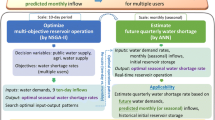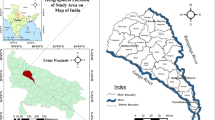Abstract
Optimal use of scarce water resources is the prime objective for water resources development projects in the developing country like India. Optimal releases have been generally expressed as a function of reservoir state variables and hydrologic inputs by a relationship which ultimately allows the policy/water managers to determine the water to be released as a function of available information. Optimal releases were obtained by using optimal control theory with inflow series and revised reservoir characteristics such as elevation area capacity table, zero elevation level as input in this study. Operating rules for reservoir were developed as a function of demand, water level and inflow. Artificial Neural Network (ANN) with back propagation algorithm, Fuzzy Logic and decision tree algorithms such as M5 and REPTree were used for deriving the operating rules using the optimal releases for an irrigation and power supply reservoir, located in northern India. It was found that fuzzy logic model performed well compared to other soft computing techniques such as ANN, M5P and REPTree investigated in this study.




Similar content being viewed by others
References
Ajmera Tapesh K, Goyal MK (2012) Development of stage discharge rating curve using model tree and neural networks: an application to Peachtree Creek in Atlanta. Expert Syst Appl 39(5):5702–5710
ASCE Task Committee on Application of Artificial Neural Networks in Hydrology (2000a) Artificial neural networks in hydrology-I: preliminary concepts. J Hydrol Eng 5(2):115–123
ASCE Task Committee on Application of Artificial Neural Networks in Hydrology (2000b) Artificial neural networks in hydrology-II: hydrologic applications. J Hydrol Eng 5(2):124–137
Cancelliere A, Guiliano G, Ancarni A, Rossi G (2002) A Neural Networks approach for deriving irrigation reservoir operating rules. Water Resour Manag 16:71–88
Celeste AB, Suzuki K, Katoda A (2008) Integrating long- and short-term reservoir operation models via stochastic and deterministic optimization: case study in Japan. J Water Resour Plan Manag 134(5):440–448
Chandramouli V, Raman H (2001) Multireservoir modelling with dynamic programming and neural networks. J Water Resour Plan Manag 127(2):89–98
Chang FJ, Chang YT (2006) Adaptive neuro-fuzzy inference system for prediction of water level in reservoir. Adv Water Resour 29(1):1–10
Chiang WC, Sheng HN (2008) “Derived operating rules for a reservoir operation system: comparison of decision trees, neural decision trees and fuzzy decision trees. Water Resour Res 44(2):W02428, 1–11
Chiu S (1994) Fuzzy Model identification based on cluster estimation. J Intell Fuzzy Syst 2(3):267–278
Daud MNR, and Corne DW (2007) “Human readable rule induction in medical data mining: A survey of existing algorithms.” In: WSEAS European Computing Conference, Athens, Greece
Deka PC, Chandramouli V (2009) Fuzzy neural network modeling of reservoir operation. J Water Resour Plan Manag 135(1):5–12
Devi S, Srivastava DK, Mohan C (2005) Optimal water allocation for the transboundary Subernarekha River, India. J Water Resour Plan Manag 131(4):253–269
Fernando DAK, Shamseldin AY (2009) Investigation of internal functioning of the radial-basis-function neural network river flow forecasting models. J Hydrol Eng 14(3):286–292
Fiacco AV, McCormick (1968) Nonlinear programming: sequential unconstrained minimization technique. Wiley, New York
Goyal MK, Burn Donald H (2012) Discussion of “Comparison of Multivariate Regression and Artificial Neural Networks for Peak Urban Water-Demand Forecasting: Evaluation of Different ANN Learning Algorithms”. J Hydrol Eng 15(10):729–743
Goyal MK, Ojha CSP (2011) Estimation of Scour Downstream of a Ski—Jump Bucket Using Support Vector and M5 Model Tree. Water Resour Manag 25(9):2177–2195
Goyal MK, Ojha CSP (2012) Downscaling of precipitation on a Lake basin: evaluation of rule and decision tree induction algorithms. Hydrol Res 43(3):215–230
Hano I, Tamura Y, Narita S (1966) An application of the maximum principle to the most economical operation power systems. IEEE Trans Power Appar Syst PAS-85(5):486–494
Hsu K-L, Gupta HV, Sorooshian S (1995) Artificial neural network modeling of the rainfall-runoff process. Water Resour Res 31(10):2517–2530
Jain A, Srinivasulu S (2004) Development of effective and efficient rainfall-runoff models using integration of deterministic, real-coded genetic algorithms and artificial neural network techniques. Water Resour Res 40(W04302):1–12
Klir J, Foger TA (1988) Fuzzy sets, uncertainty, and information. Prentice-Hall, Englewood Cliffs
Labadie JW (2004) Optimal operation of Multireservoir systems: State-of-the-art review. J Water Resour Plan Manag 130(2):93–111
Lasdon LS, Waren AD, Rice RK (1967) An interior penalty method for inequality constrained optimal control problems. IEEE Trans Autom Control AC-12(4):388–395
Liu X, Guo S, Liu P, Chen L, Li X (2011) “Deriving Optimal Refill Rules for Multi-Purpose Reservoir Operation“. Water Resour Manag 25(2):431–448
Loucks DP (1992) Water resource systems models: their role in planning. J Water Resour Plan Manag 118(3):214–223
Maier HR, Dandy GC (2000) Neural networks for the prediction and forecasting of water resources variables: a review of modelling issues and applications. Environ Model Softw 15:101–124
Mcmahon GF, Farmer MC (2009) Rule based storage accounting for multipurpose reservoir systems. J Water Resour Plan Manag 135(4):286–297
Mcmahon TA, Adeloye AJ, Zhou SL (2006) Understanding performance measures of reservoirs. J Hydrol 324(1–4):359–382
Metternicht G (2001) Assessing temporal and spatial changes of salinity using fuzzy logic, remote sensing and GIS Foundations of an expert system. Ecol Model 144:163–179
Minns AW, Hall MJ (1996) Artificial neural networks as rainfall runoff models. Hydrol Sci J 41(3):399–417
Mizyed NR, Loftis JC, Fontane DG (1992) Operation of large multireservoir systems using optimal control theory. J Water Resour Plan Manag 118(4):371–387
Ojha CSP, Goyal MK, Kumar S (2007) Applying Fuzzy logic and the point count system to select landfill sites. Environ Monit Assess 135(1–3):99–106
Quinlan JR (1992) Learning with continuous classes. Proc. of the Fifth Australian Joint Conference on Artificial Intelligence. World Scientific, Singapore, pp 343–348
Raman H, Chandramouli V (1996) Deriving a general operating policy for reservoirs using Neural Network. J Water Resour Plan Manag 122(5):342–347
Rao Z, Moore IN, O’Connell PE, Jamieson DG (2001) An Interactive Management System for Operational Control of Kirazdere Reservoir (Turkey). Water Resour Manag 15(4):223–234
Rumelhart DE, Hinton E, Williams J (1986) Learning internal representation by error propagation, Parallel Distributed Processing, Vol. 1. MIT Press, Cambridge, pp 318–362
Senthil kumar AR, Sudheer KP, Jain SK, Agarwal PK (2005) “Rainfall-runoff modelling using artificial neural networks: comparison of network types”. Hydrol Process 19:1277–1291
Senthil kumar AR, Ojha CSP, Goyal MK, Singh RD, Swamee PK (2012) “Modelling of Suspended Sediment Concentration at Kasol in India using ANN, Fuzzy Logic and Decision Tree Algorithms”. J Hydrol Eng 17(3):394–404
Shiau J-T (2011) “Analytical optimal hedging with explicit incorporation of reservoir release and carryover storage targets“. Water Resour Res 47(W01515):17
Srinivasulu S, Jain A (2009) River flow prediction using an integrated approach. J Hydrol Eng 14(1):75–83
Sudheer KP, Gosain AK, Ramasastri KS (2002) A data-driven algorithm for constructing artificial neural network rainfall-runoff models. Hydrol Process 16(6):1325–1330
Swamee PK (2001) Reservoir capacity depletion on account of sedimentation. Int J Sediment Res 16(3):408–415
Thirumalaiah K, Deo MC (1998) River stage forecasting using artificial neural networks. J Hydrol Eng 3(1):26–32
Vos NJ, Rientjes THM (2008) Multiobjective training of artificial neural networks for rainfall-runoff modelling. Water Resour Res 44(W08434):1–15
Witten IH, Frank E (2005) Data mining: practical machine learning tools and techniques, 2nd edn. Morgan Kaufmann, San Francisco
Witten IH, Frank E, Trigg L, Hall M, Holmes G, and Cunningham SJ (1999) “Weka: Practical machine learning tools and techniques with java implementations.” In: Emerging Knowledge Engineering and Connectionist-Based Information Systems, 192–196
Wurbs RA (1993) Reservoir-system simulation and optimization models. J Water Resour Plan Manag 119(4):455–472
Yeh WW-G (1985) Reservoir management and operations models: a state-of-the-art review. Water Resour Res 21(12):1797–1818
Zadeh LA (1965) Fuzzy sets. Inf Controls 8(3):353–383
Zadeh LA (1983) The role of fuzzy logic in the management of uncertainty in expert systems. Fuzzy Set Syst 11:199–227
Author information
Authors and Affiliations
Corresponding author
Rights and permissions
About this article
Cite this article
kumar, A.R.S., Goyal, M.K., Ojha, C.S.P. et al. Application of ANN, Fuzzy Logic and Decision Tree Algorithms for the Development of Reservoir Operating Rules. Water Resour Manage 27, 911–925 (2013). https://doi.org/10.1007/s11269-012-0225-8
Received:
Accepted:
Published:
Issue Date:
DOI: https://doi.org/10.1007/s11269-012-0225-8




